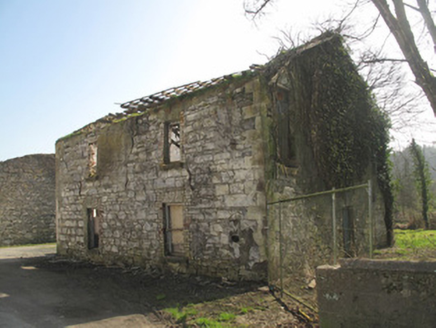Survey Data
Reg No
41400421
Rating
Regional
Categories of Special Interest
Architectural, Social
Original Use
Hall
Historical Use
Forge/smithy
Date
1845 - 1855
Coordinates
270359, 346626
Date Recorded
28/03/2012
Date Updated
--/--/--
Description
Detached two-bay two-storey village hall, built c.1850. Now derelict. Frame of pitched roof remains. Coursed rubble limestone walls with remnants of roughcast render, tooled block-and-start sandstone quoins, cast-iron wall-ties, and portion of cast-iron downpipe draining inwards through front (north-west) elevation. Gauged-brick square-headed window openings with red brick block-and-start surrounds, masonry sills and one-over-one pane timber sliding sash windows, some absent or blocked. Square-headed door openings to north-east elevation at first and ground floor levels, having render reveal and timber fittings. Concrete canopy on square-plan pillars to first floor opening. Square-headed door openings to south-west elevation at first and ground floor levels, with double-leaf timber battened door to ground floor and single-leaf timber battened door at first floor level.
Appraisal
This substantial building functioned as the dance hall for the village, constituting an important social and recreational space. By the 1900s it is recorded as a smithy on the OS maps. To the front wall, a remaining portion of downpipe seems to channel water from the roof back inside the building, which could have been used for the purposes of cooling forged metal, however there was also a small mill race and sluice to one side of the building (no longer extant). Like its neighbouring building, it is currently derelict, although it retains much of its original form and fabric, with timber sliding sash windows, brick window surrounds and tooled sandstone quoins adding architectural interest as well as providing a sense of uniformity with its neighbouring sites. The village of Mullan was built in the nineteenth century to house and serve the needs of the workers of the flax and woollen mill, and in the following century, the boot factory subsequently established there. Mill villages such as this were constructed throughout Ulster during the eighteenth and nineteenth centuries and reflect the strong industrial capabilities of this area.

